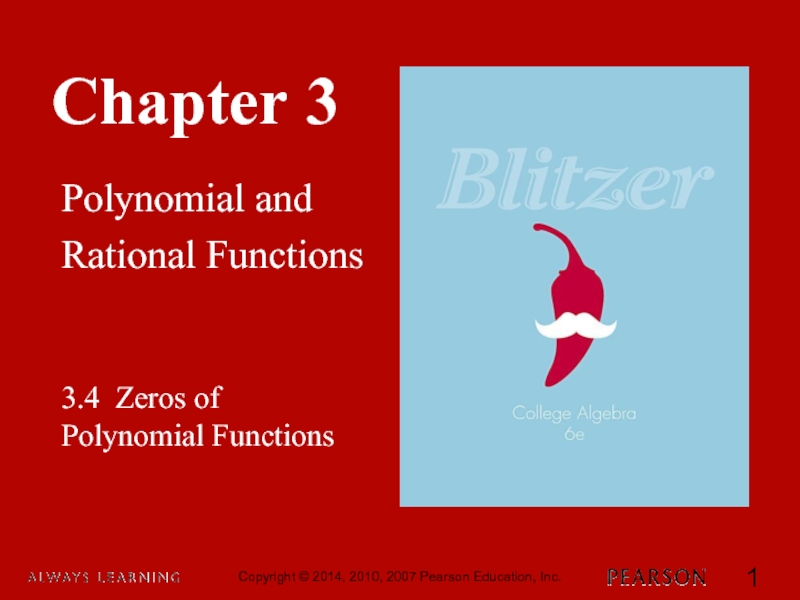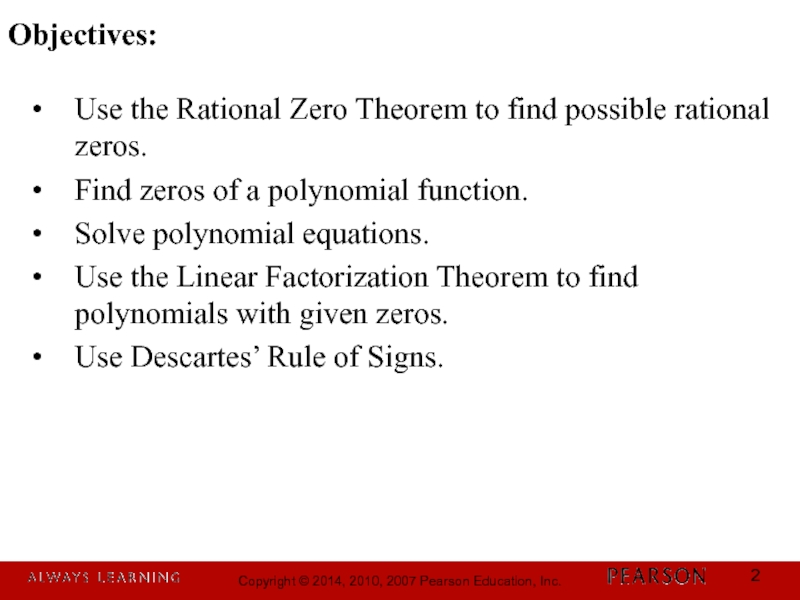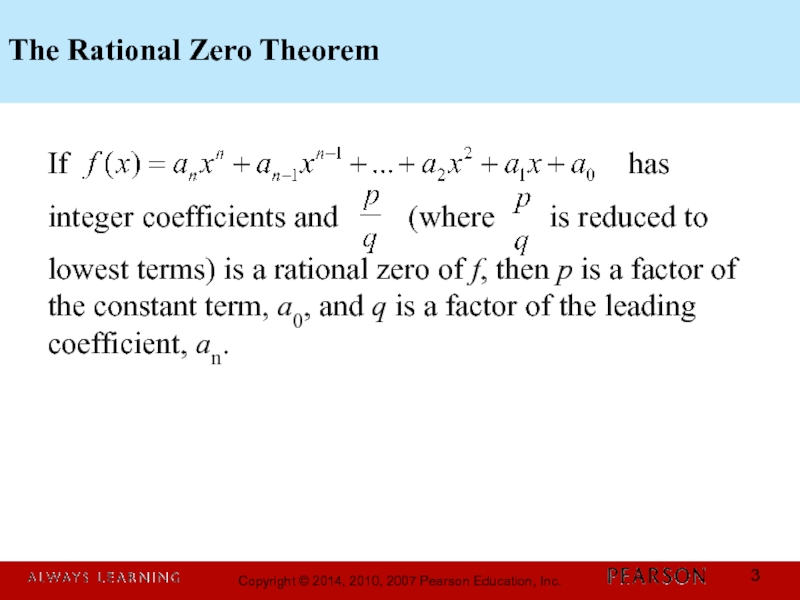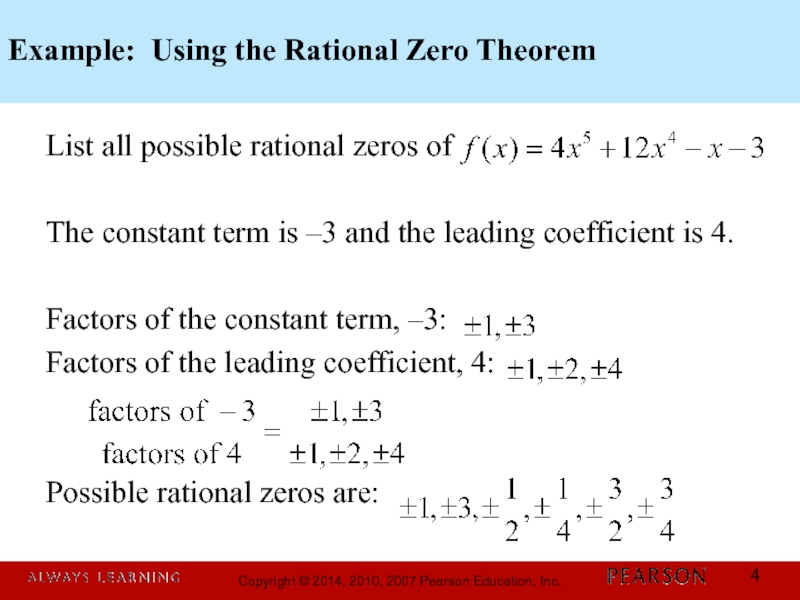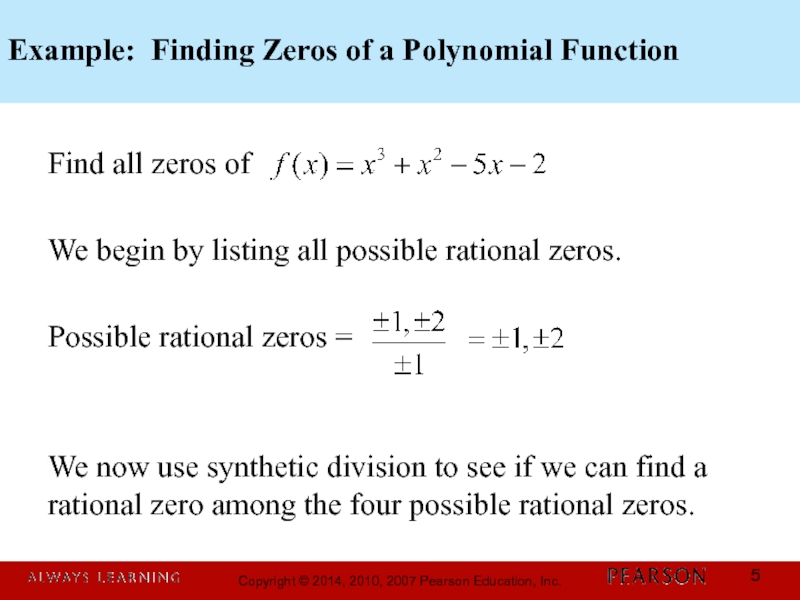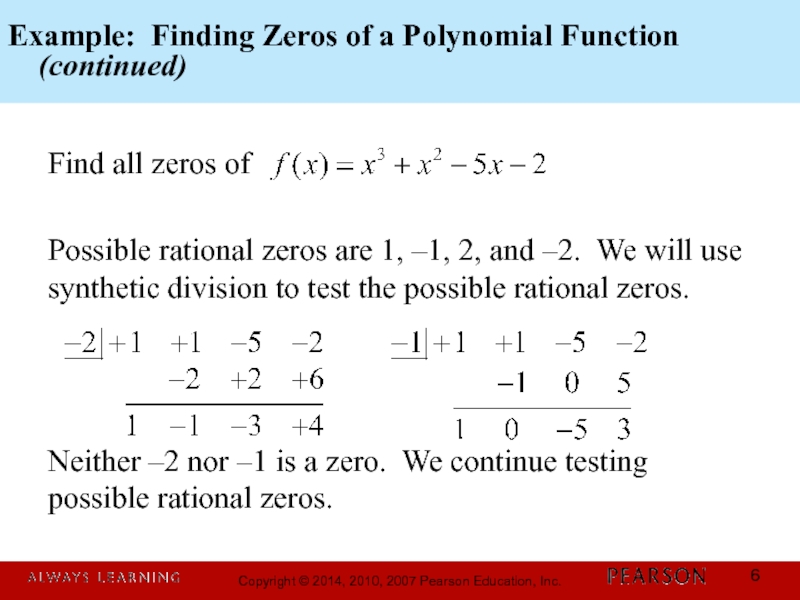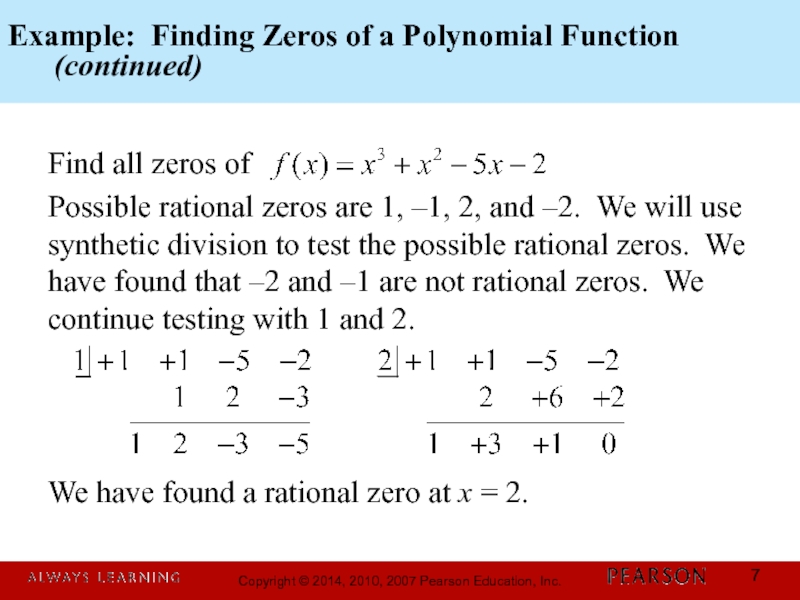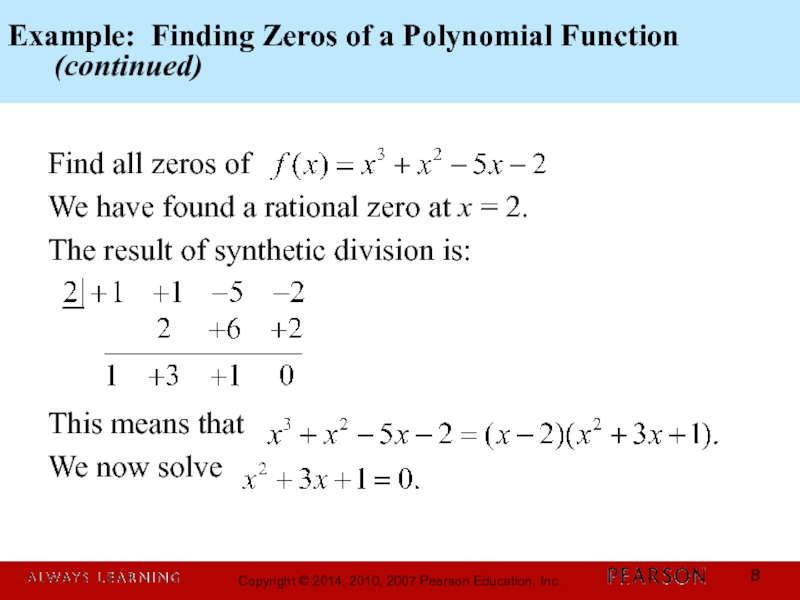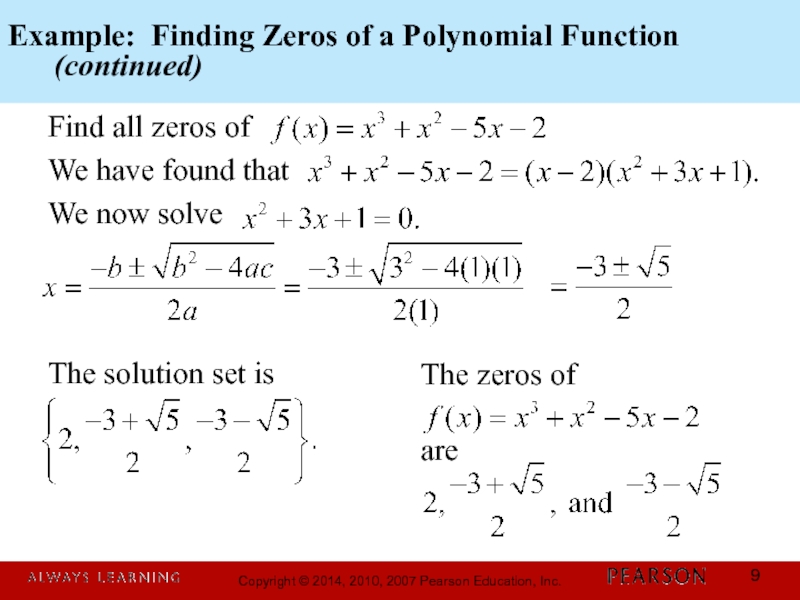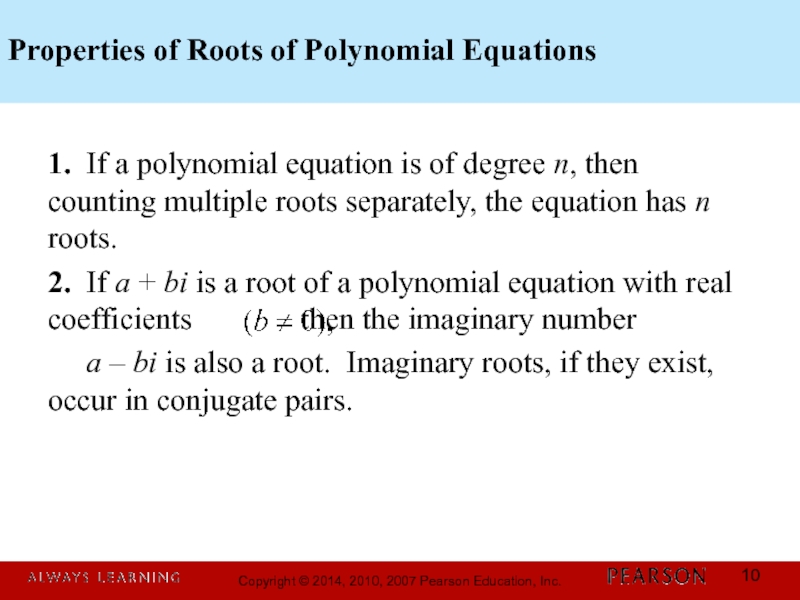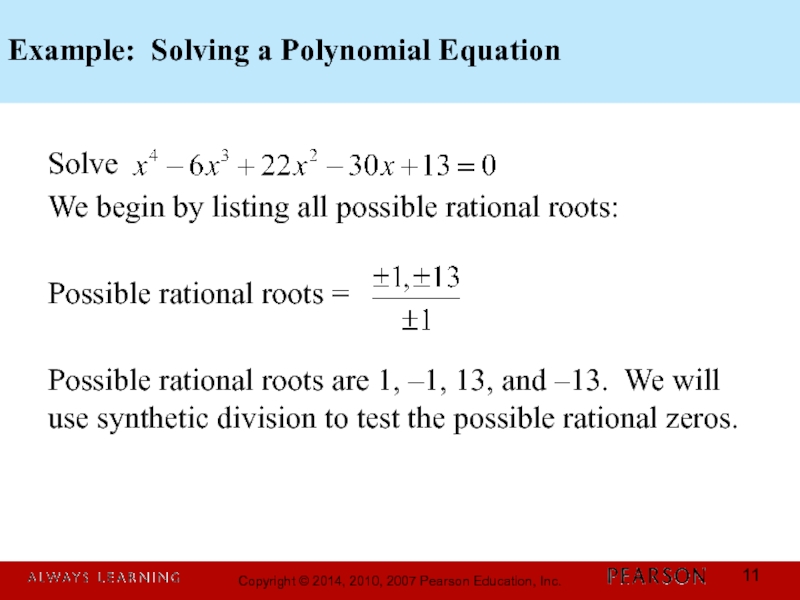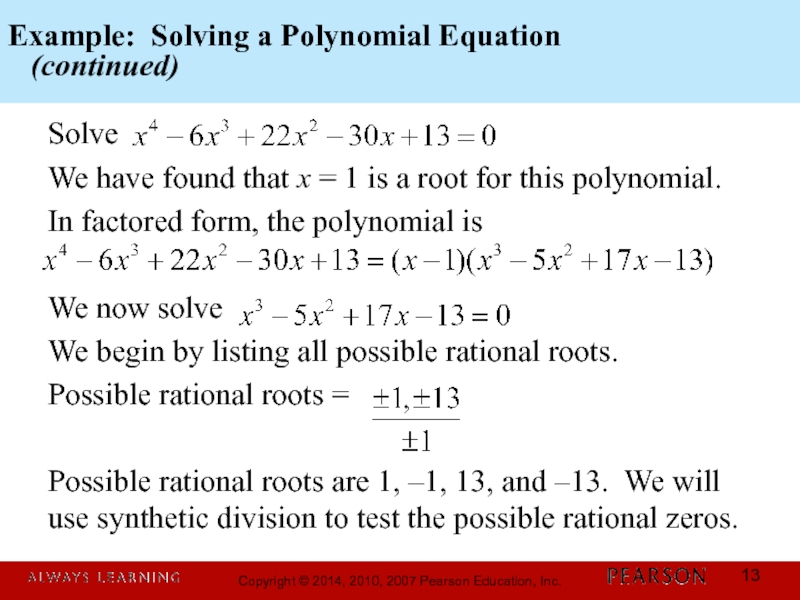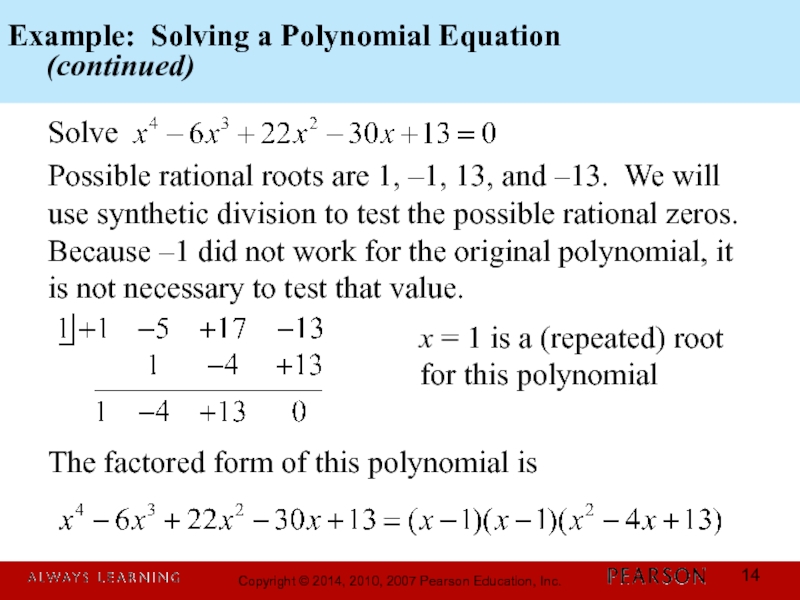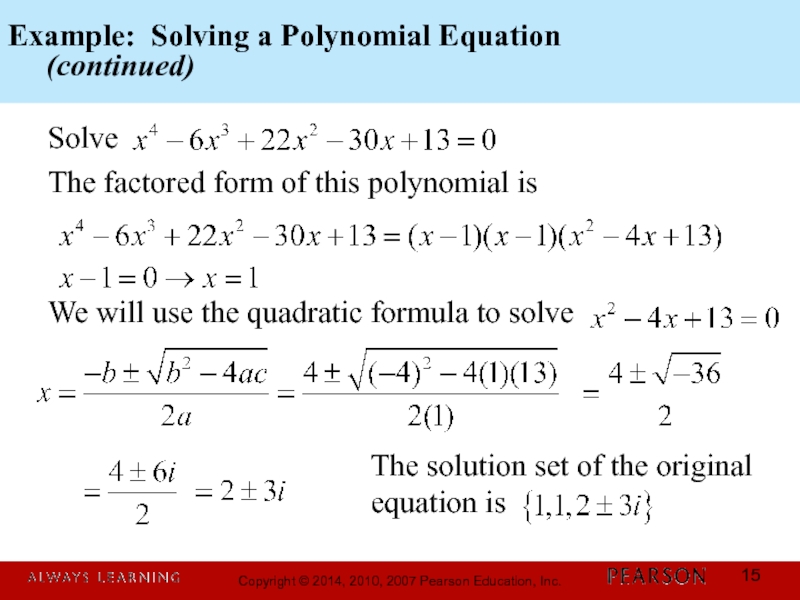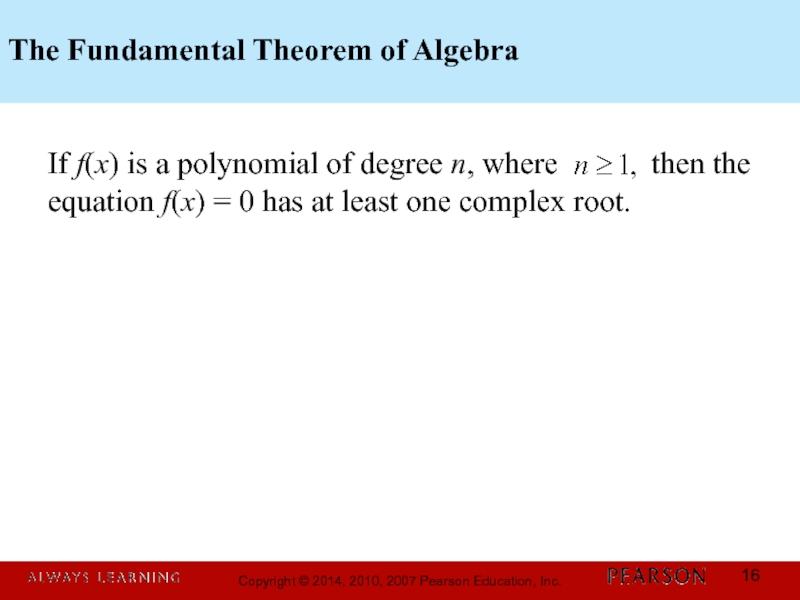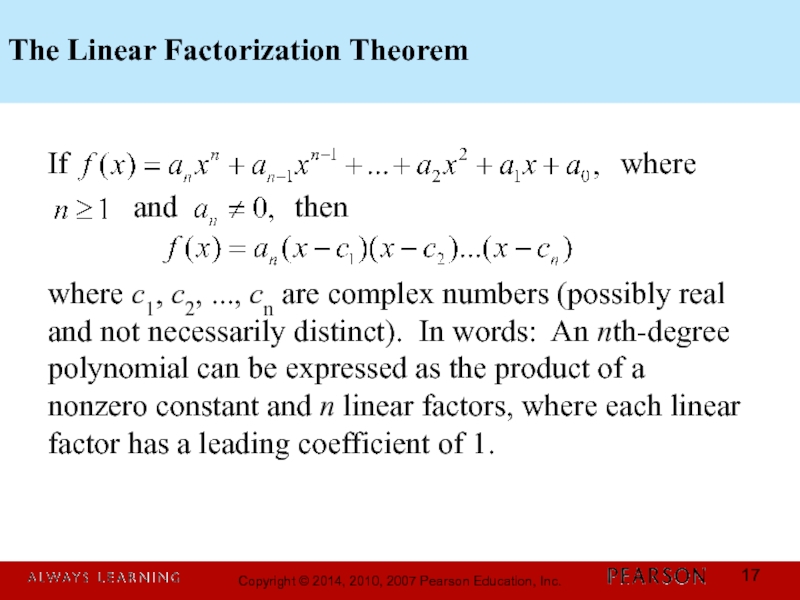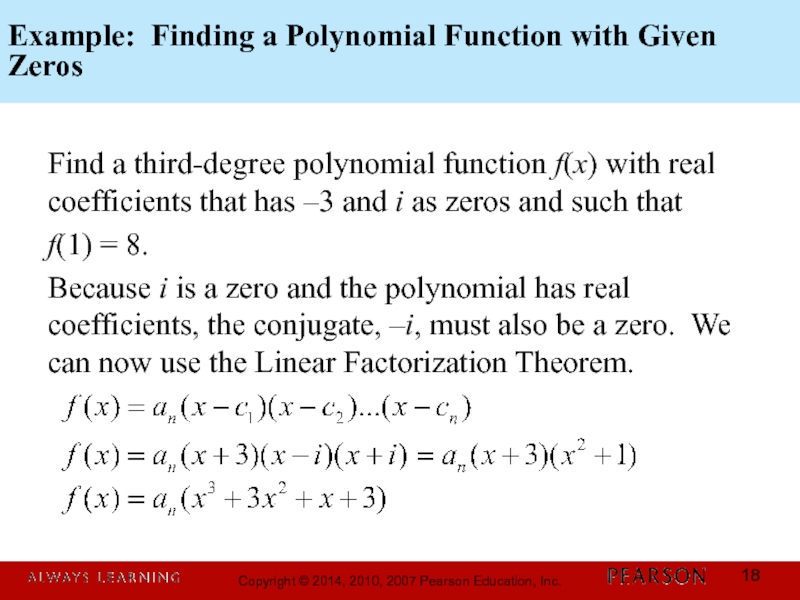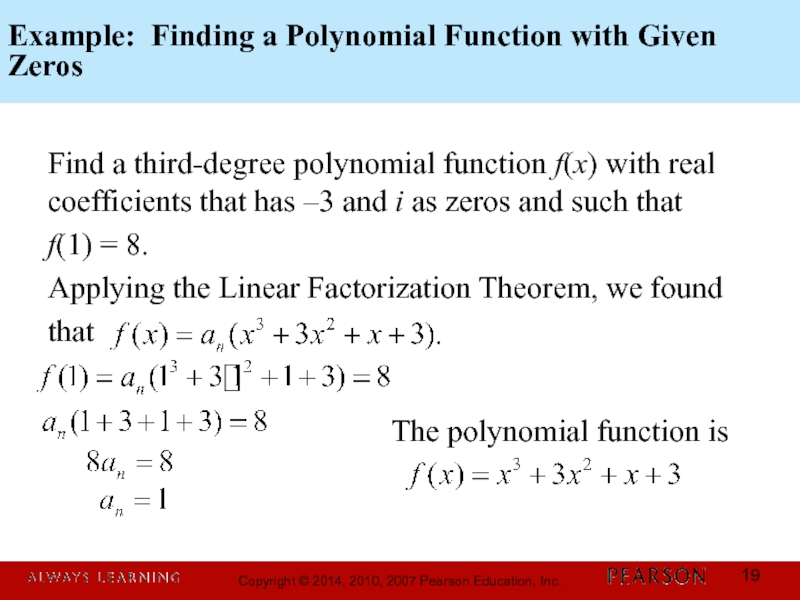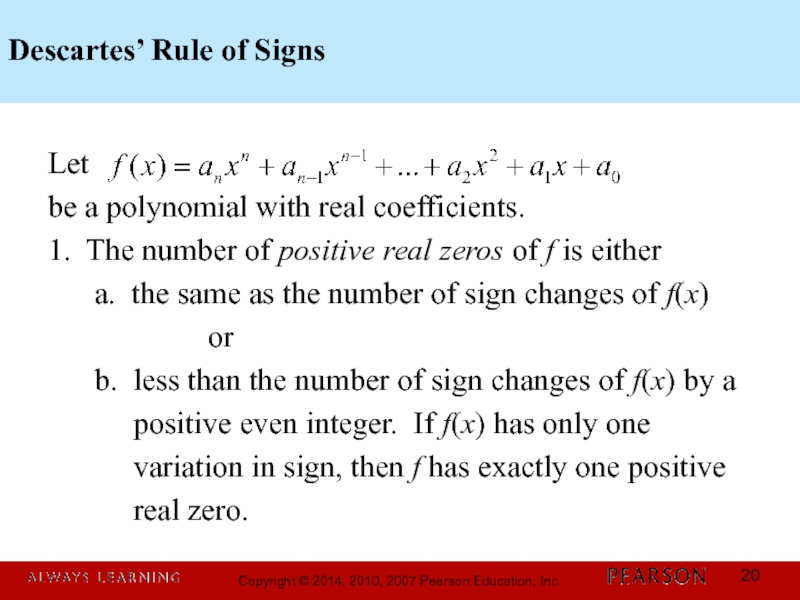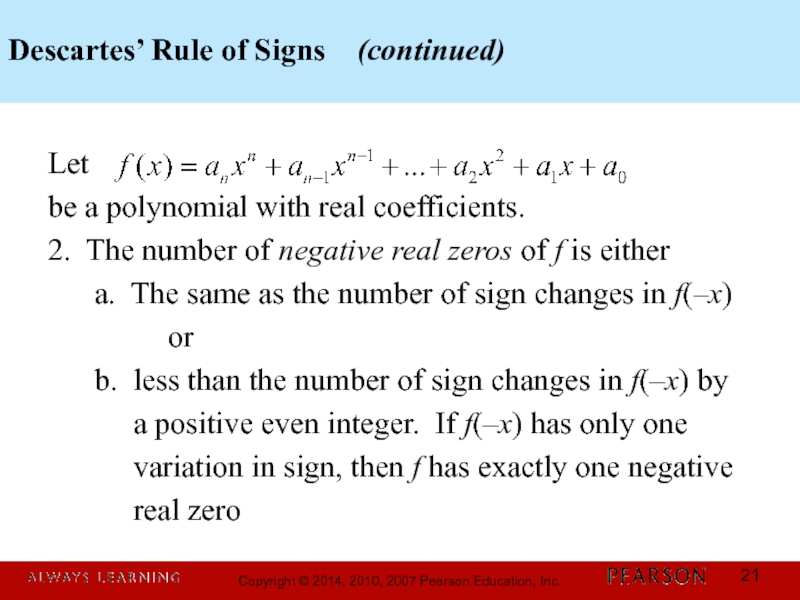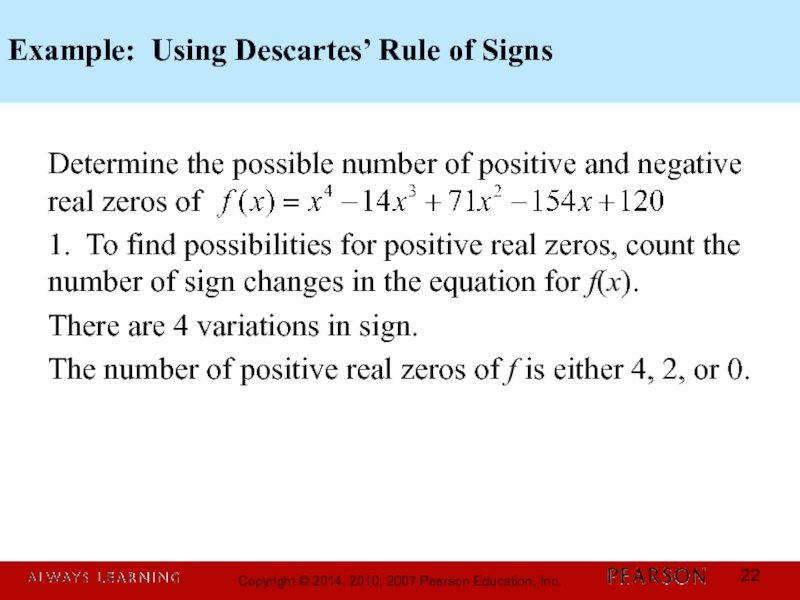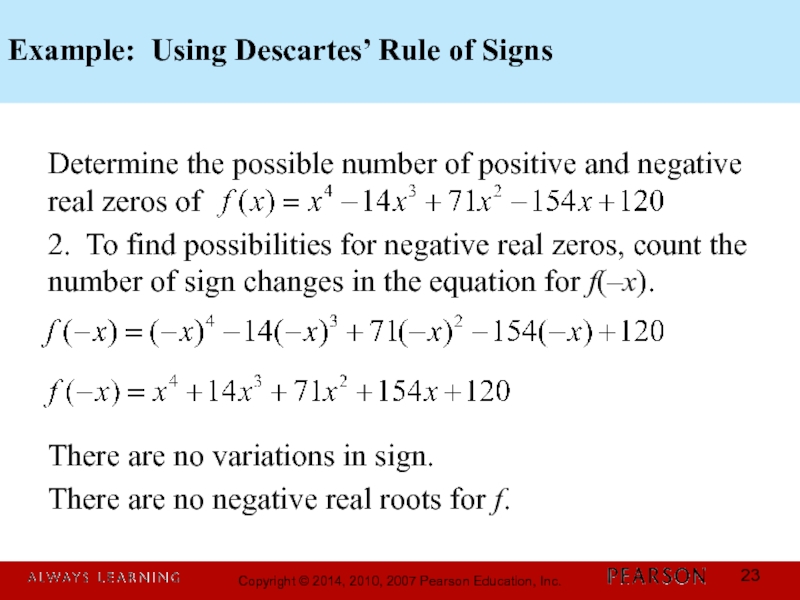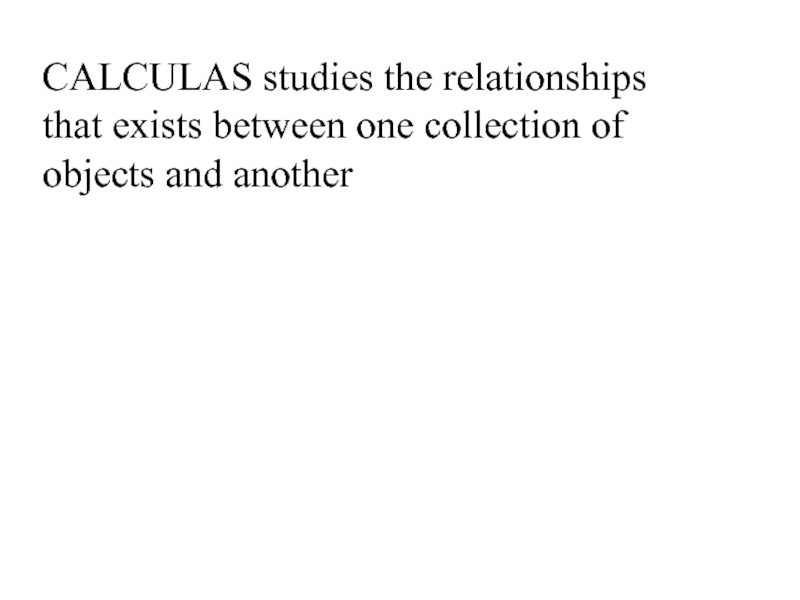3.4 Zeros of
Polynomial Functions
- Главная
- Разное
- Дизайн
- Бизнес и предпринимательство
- Аналитика
- Образование
- Развлечения
- Красота и здоровье
- Финансы
- Государство
- Путешествия
- Спорт
- Недвижимость
- Армия
- Графика
- Культурология
- Еда и кулинария
- Лингвистика
- Английский язык
- Астрономия
- Алгебра
- Биология
- География
- Детские презентации
- Информатика
- История
- Литература
- Маркетинг
- Математика
- Медицина
- Менеджмент
- Музыка
- МХК
- Немецкий язык
- ОБЖ
- Обществознание
- Окружающий мир
- Педагогика
- Русский язык
- Технология
- Физика
- Философия
- Химия
- Шаблоны, картинки для презентаций
- Экология
- Экономика
- Юриспруденция
Chapter 3. Polynomial and Rational Functions. 3.4 Zeros of Polynomial Functions презентация
Содержание
- 1. Chapter 3. Polynomial and Rational Functions. 3.4 Zeros of Polynomial Functions
- 2. Use the Rational Zero Theorem to find
- 3. The Rational Zero Theorem If
- 4. Example: Using the Rational Zero Theorem List
- 5. Example: Finding Zeros of a Polynomial Function
- 6. Example: Finding Zeros of a Polynomial Function
- 7. Example: Finding Zeros of a Polynomial Function
- 8. Example: Finding Zeros of a Polynomial Function
- 9. Example: Finding Zeros of a Polynomial Function
- 10. Properties of Roots of Polynomial Equations 1.
- 11. Example: Solving a Polynomial Equation Solve We
- 12. Example: Solving a Polynomial Equation
- 13. Example: Solving a Polynomial Equation
- 14. Example: Solving a Polynomial Equation
- 15. Example: Solving a Polynomial Equation
- 16. The Fundamental Theorem of Algebra If f(x)
- 17. The Linear Factorization Theorem If
- 18. Example: Finding a Polynomial Function with Given
- 19. Example: Finding a Polynomial Function with Given
- 20. Descartes’ Rule of Signs Let be a
- 21. Descartes’ Rule of Signs (continued) Let
- 22. Example: Using Descartes’ Rule of Signs Determine
- 23. Example: Using Descartes’ Rule of Signs Determine
Слайд 1 Chapter 3
Polynomial and
Rational Functions
Copyright © 2014, 2010, 2007 Pearson Education,
Слайд 2Use the Rational Zero Theorem to find possible rational zeros.
Find zeros
Solve polynomial equations.
Use the Linear Factorization Theorem to find polynomials with given zeros.
Use Descartes’ Rule of Signs.
Objectives:
Слайд 3The Rational Zero Theorem
If
integer coefficients and (where is reduced to
lowest terms) is a rational zero of f, then p is a factor of the constant term, a0, and q is a factor of the leading coefficient, an.
Слайд 4Example: Using the Rational Zero Theorem
List all possible rational zeros of
The
Factors of the constant term, –3:
Factors of the leading coefficient, 4:
Possible rational zeros are:
Слайд 5Example: Finding Zeros of a Polynomial Function
Find all zeros of
We
Possible rational zeros =
We now use synthetic division to see if we can find a rational zero among the four possible rational zeros.
Слайд 6Example: Finding Zeros of a Polynomial Function
(continued)
Find all zeros
Possible rational zeros are 1, –1, 2, and –2. We will use synthetic division to test the possible rational zeros.
Neither –2 nor –1 is a zero. We continue testing possible rational zeros.
Слайд 7Example: Finding Zeros of a Polynomial Function
(continued)
Find all
Possible rational zeros are 1, –1, 2, and –2. We will use synthetic division to test the possible rational zeros. We have found that –2 and –1 are not rational zeros. We continue testing with 1 and 2.
We have found a rational zero at x = 2.
Слайд 8Example: Finding Zeros of a Polynomial Function
(continued)
Find all
We have found a rational zero at x = 2.
The result of synthetic division is:
This means that
We now solve
Слайд 9Example: Finding Zeros of a Polynomial Function
(continued)
Find all
We have found that
We now solve
The solution set is
The zeros of
are
Слайд 10Properties of Roots of Polynomial Equations
1. If a polynomial equation is
2. If a + bi is a root of a polynomial equation with real coefficients then the imaginary number
a – bi is also a root. Imaginary roots, if they exist, occur in conjugate pairs.
Слайд 11Example: Solving a Polynomial Equation
Solve
We begin by listing all possible rational
Possible rational roots =
Possible rational roots are 1, –1, 13, and –13. We will use synthetic division to test the possible rational zeros.
Слайд 12Example: Solving a Polynomial Equation
(continued)
Solve
Possible rational roots are
x = 1 is a root for this polynomial.
We can rewrite the equation in factored form
Слайд 13Example: Solving a Polynomial Equation
(continued)
Solve
We have found that x
In factored form, the polynomial is
We now solve
We begin by listing all possible rational roots.
Possible rational roots =
Possible rational roots are 1, –1, 13, and –13. We will use synthetic division to test the possible rational zeros.
Слайд 14Example: Solving a Polynomial Equation
(continued)
Solve
Possible rational roots are
The factored form of this polynomial is
x = 1 is a (repeated) root
for this polynomial
Слайд 15Example: Solving a Polynomial Equation
(continued)
Solve
The factored form of
We will use the quadratic formula to solve
The solution set of the original
equation is
Слайд 16The Fundamental Theorem of Algebra
If f(x) is a polynomial of degree
Слайд 17The Linear Factorization Theorem
If
and then
where c1, c2, ..., cn are complex numbers (possibly real and not necessarily distinct). In words: An nth-degree polynomial can be expressed as the product of a nonzero constant and n linear factors, where each linear factor has a leading coefficient of 1.
Слайд 18Example: Finding a Polynomial Function with Given Zeros
Find a third-degree polynomial
f(1) = 8.
Because i is a zero and the polynomial has real coefficients, the conjugate, –i, must also be a zero. We can now use the Linear Factorization Theorem.
Слайд 19Example: Finding a Polynomial Function with Given Zeros
Find a third-degree polynomial
f(1) = 8.
Applying the Linear Factorization Theorem, we found
that
The polynomial function is
Слайд 20Descartes’ Rule of Signs
Let
be a polynomial with real coefficients.
1. The number
a. the same as the number of sign changes of f(x)
or
b. less than the number of sign changes of f(x) by a
positive even integer. If f(x) has only one
variation in sign, then f has exactly one positive
real zero.
Слайд 21Descartes’ Rule of Signs (continued)
Let
be a polynomial with real coefficients.
2.
a. The same as the number of sign changes in f(–x)
or
b. less than the number of sign changes in f(–x) by
a positive even integer. If f(–x) has only one
variation in sign, then f has exactly one negative
real zero
Слайд 22Example: Using Descartes’ Rule of Signs
Determine the possible number of positive
1. To find possibilities for positive real zeros, count the number of sign changes in the equation for f(x).
There are 4 variations in sign.
The number of positive real zeros of f is either 4, 2, or 0.
Слайд 23Example: Using Descartes’ Rule of Signs
Determine the possible number of positive
2. To find possibilities for negative real zeros, count the number of sign changes in the equation for f(–x).
There are no variations in sign.
There are no negative real roots for f.
